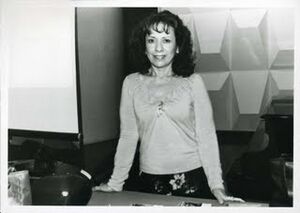Alicia Urreta facts for kids
Alicia Urreta (born October 12, 1930 – died December 20, 1986) was a talented Mexican musician. She was a skilled pianist, a music teacher, and a composer. This means she wrote her own music.
Biography
Alicia Urreta was born in Veracruz, Veracruz, a city in Mexico. In 1952, she began her music studies at the National Conservatory of Music in Mexico City. There, she learned about harmony from Rodolfo Halffter and other subjects from different teachers.
Later, in 1969, she traveled to Paris, France. She studied at the Schola Cantorum with Jean-Etienne Marie. She also took piano lessons from famous pianists like Alfred Brendel and Alicia de Larrocha.
Alicia Urreta became a concert pianist for the National Symphony Orchestra. She also taught music at the University of Mexico. She even taught about acoustics, which is the science of sound, at the National Polytechnic Institute.
Urreta helped create the National Symphony Orchestra in 1975. She was also a main coordinator for the National Opera Company. She directed musical performances for the National Autonomous University of Mexico. She also started a music group called the Camerata of Mexico.
In 1984, she began organizing music festivals. These festivals helped share new music from Mexico and Spain. She worked with Spanish composer Cruz de Castro on these events. In 1982, she performed her own "Concerto for Piano and Orchestra" with the National Symphony Orchestra. Alicia Urreta passed away in Mexico City in 1986.
Works
Alicia Urreta wrote many different kinds of music. Her works include an opera, several ballets, and pieces for solo instruments. She also composed a cantata, which is a vocal piece, and music for plays. She even created music using recorded sounds, called musique concrète, for a Japanese Noh theater play and for films.
Stage
- Cubos (ballet)
- Luiz negra (ballet)
- Mujer flor (ballet)
- Un día de Luis (ballet with electronic music)
- Tantra (ballet with musique concrète)
- Cante, homenaje a Manuel de Falla (for actors, singers, dancers, slides, percussion, and tape, 1976)
- Romance do Doña Balada (opera, 1973)
Orchestral
- Ralenti (for tape, 1969)
- Arcana (concerto for amplified piano and orchestra)
Chamber
- Homage (for string quartet)
- Estudio sobre una guitarra (for tape)
- Salmodia II (for piano and tape, 1980)
- De Natura mortis o la Verdadera historia de Caperucita Roja (for narrator, instruments, and tape, 1971)
- Selva de Pájaros (for tape, 1978)
- Dameros II (for tape, 1984)
- Dameros III (for tape, 1985)
See also
 In Spanish: Alicia Urreta para niños
In Spanish: Alicia Urreta para niños


